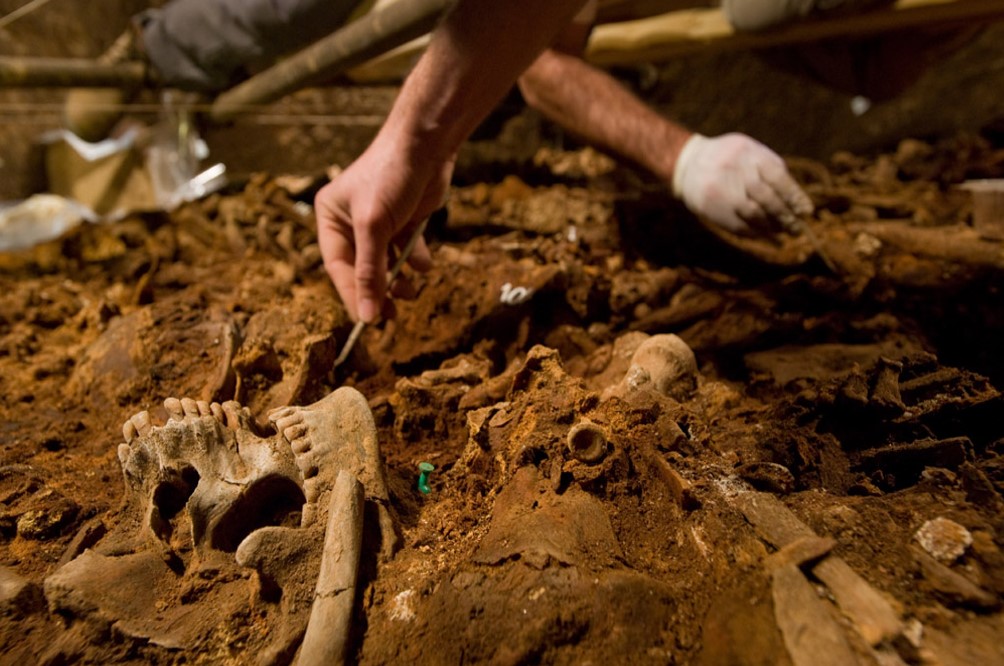About Archaeothanatology

Since the second half of the 20th century, archaeology has undergone a major scientific transformation by prioritizing the analysis of human remains within their depositional context. This new approach serves as a nexus between fieldwork and laboratory analysis and has gradually led to profound conceptual and methodological reconsiderations of burials as an archaeological source.
This has led to the emergence of a new discipline combining biological, social and cultural aspects of death, which found its roots and fertile ground within the French research community. Initially known as "field anthropology", this discipline is now called "Archaeothanatology" or "The Archaeology of Death".
The term archaeothanatology, derived from "archaeo" (ancient) and "thanatology" (from Thanatos, the personification of death), is a transliteration of the French "archéothanatologie". Emerging from a Zeitgeist influenced by French archaeologists such as A. Leroi-Gourhan, G. Bailloud, and M. Brézillon during the excavation of the Mournouards site (Chambon et Blin, 2011 ; Leroi-Gourhan et al., 1962), the discipline was later theorized by H. Duday in the 1970s (Duday, 1990 ; Duday et al., 1990 ; Duday, 2006, 1978 ; Duday et Masset, 1987 ; Duday, 2005).
This interdisciplinary field seeks to reconstruct the funerary customs carried out around the body of the deceased, as well as the organisation and arrangement of funerary spaces, in order to draw social conclusions and interpret mortuary behaviours. One of the fundamental procedures for understanding taphonomic processes (such as anomalies in the position of bones, constraints and displacements) is to observe the sequence of disarticulation of joints in the body.
SELECTION OF REFERENCES
CHAMBON, P., & BLIN, A. (2011). Gérard Bailloud, co-fondateur de «l'archéologie de la mort». Bulletin de la Société préhistorique française, 108(3), 541-544. https://www.jstor.org/stable/23241799
DUDAY H. (2009) ‒The archaeology of the dead: lectures in archaeothanatology, Oxford, Oxbow Books. https://www.torrossa.com/it/resources/an/5327639
DUDAY H., et al.. (2006) Lezioni di archeotanatologia: archeologia funeraria e antropologia di campo., Rome. https://shs.hal.science/hal-00339268/
DUDAY H., et al.(1990) L'Anthropologie « de terrain » : reconnaissance et interprétation des gestes funéraires, Bulletins et Mémoires de la Société d'Anthropologie de Paris, 2, 3, p. 29‑49. https://www.persee.fr/doc/bmsap_0037-8984_1990_num_2_3_1740
DUDAY H. (1978) Archéologie funéraire et anthropologie. Application des relevés et de l'étude ostéologiques à l'interprétation de quelques sépultures pré-et protohistoriques du midi de la France, Cahiers d'Anthropologie Paris, 1, p. 55‑101. https://www.persee.fr/doc/bmsap_0037-8984_1990_num_2_3_1740
KNÜSEL C.J., SCHOTSMANS E.M. (2022) ‒The Routledge Handbook of Archaeothanatology: Bioarchaeology of Mortuary Behaviour, Routledge. https://doi.org/10.4324/9781351030625
LEROI-GOURHAN A., et al. 1962 L'hypogée II des Mournouards (Mesnil-sur-Oger, Marne). Gallia Prehistoire 5 (1), p. 23–133